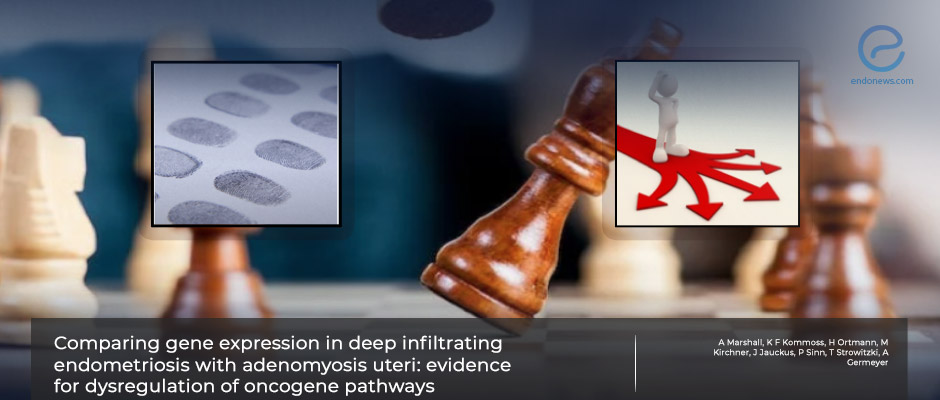Deep Infiltrating Endometriosis and Adenomyosis have different genetic pathways
May 23, 2023
Oncogene Pathways in Focus: Deep Infiltrating Endometriosis differs from adenomyosis at the RNA level.
Key Points
Highlights:
- The gene expression patterns between deep infiltrating endometriosis (DIE) and adenomyosis, reveal an oncogenic pattern.
Importance:
- Understanding the molecular basis of gynecological disorders is crucial for developing targeted therapies and improving management strategies.
- Comparing gene expression patterns can provide insights into dysregulated pathways and potential oncogenic processes.
What's done here:
- The tissue samples from 19 patients diagnosed with DIE and 7 patients with adenomyosis have been collected and the epithelium laser dissected.
- Gene expression profiling techniques and RNA sequencing have been utilized to analyze gene expression levels.
- Bioinformatics analysis has been applied to compare gene expression profiles and altered pathways between the two conditions.
Key Results:
- Distinct patterns of gene expression identified in DIE compared to adenomyosis.
- Upregulation of oncogenes observed in DIE samples, suggests a potential link between deep infiltrating endometriosis and increased oncogenic risk.
- Dysregulation of the PI3K/AKT/mTOR pathway, which regulates cell growth and survival, was observed in DIE samples.
- The RAS pathway activation was the dominant activated pathway in adenomyosis tissues.
Limitations:
- The study focused on comparing gene expression patterns and did not investigate functional implications or causative relationships.
- The sample size may be limited, and results should be validated in larger cohorts.
Lay Summary
It is still not defined whether adenomyosis is also a deep endometriosis component or not. In the study conducted by Marshall et al, the researchers compared the gene expression patterns between deep infiltrating endometriosis (DIE) and adenomyosis uteri in order to identify potential dysregulation of oncogene pathways. The researchers utilized gene expression profiling techniques to analyze tissue samples from patients diagnosed with either DIE or adenomyosis.
After collecting the tissue samples from patients diagnosed with either DIE or adenomyosis during surgical procedures, RNA sequencing was performed to identify and quantify gene expression levels. Subsequent bioinformatics analysis techniques were employed to compare the gene expression profiles between the two conditions.
The study's results revealed distinct gene expression patterns in both conditions. In DIE samples, several oncogenes were found to be upregulated compared to adenomyosis samples. This finding suggests a potential link between deep infiltrating endometriosis and an increased risk of oncogenic processes. Furthermore, the dysregulation of specific oncogene pathways, such as the PI3K/AKT/mTOR pathway, was observed in DIE samples while RAS pathway genes were altered in adenomyosis samples. This pathway plays a crucial role in regulating cell growth, proliferation, and survival.
The dysregulation of the PI3K/AKT/mTOR pathway in DIE suggests a potential involvement of this pathway in the pathogenesis of the condition while when it comes to adenomyosis the leading pathway was found as the RAS pathway.
The study highlights the importance of understanding the molecular mechanisms underlying gynecological conditions like deep infiltrating endometriosis and adenomyosis. Researchers have identified potential dysregulation of oncogene pathways in deep infiltrating endometriosis by comparing the gene expression patterns between these two conditions.
Further research is warranted to elucidate the precise role of these dysregulated pathways in the development and progression of the disease. Understanding the dysregulated gene expression patterns and oncogene pathways associated with this condition may overlay the way for the development of targeted therapies and improved management strategies in the future. The paper was published in the April 2023 issue of Reproductive Biology and Endocrinology.
Research Source: https://pubmed.ncbi.nlm.nih.gov/37005590/
adenomyosis DIE oncogenic pathways deep infiltrating endometriosis gene expression RAS PI3K/AKT/mTOR

